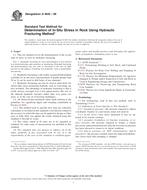Potřebujeme váš souhlas k využití jednotlivých dat, aby se vám mimo jiné mohly ukazovat informace týkající se vašich zájmů. Souhlas udělíte kliknutím na tlačítko „OK“.
ASTM D4645-08
Standard Test Method for Determination of In-Situ Stress in Rock Using Hydraulic Fracturing Method (Withdrawn 2017)
Automaticky přeložený název:
Standardní zkušební metoda pro stanovení in-situ napětí ve skále Pomocí hydraulického štěpení metody
NORMA vydána dne 1.7.2008
Informace o normě:
Označení normy: ASTM D4645-08
Poznámka: NEPLATNÁ
Datum vydání normy: 1.7.2008
Kód zboží: NS-28014
Počet stran: 7
Přibližná hmotnost: 21 g (0.05 liber)
Země: Americká technická norma
Kategorie: Technické normy ASTM
Kategorie - podobné normy:
Zemní práce. Hloubicí práce. Budování základů. Podzemní práce
Anotace textu normy ASTM D4645-08 :
Keywords:
drill holes, fluid pressure, hydraulic fracturing, in situ stress, Breakdown pressure, Cavern design, Field testing--rock, Fracture testing--rock, Hydraulic properties, Hydrofractured rock, In-situ soil/rock testing/analysis, Minifracturing, Permeability--soil/rock, Porosity, Pressure testing--rock, Pressure tunnel lining, Rock materials/properties/analysis, Stress--rock, Tensile properties/testing--soil/rock/related materials, Tunnels
Doplňující informace
| Significance and Use | ||||||||||
|
Limitations: The depth of measurement is limited only by the length of the test hole. Presently, the results of the hydraulic fracturing method can be interpreted in terms of in-situ stresses only if the boreholes are approximately parallel to one of the three principal in-situ stresses. Unless evidence to the contrary exists, vertical boreholes are assumed to be parallel to one of the in-situ principal stresses. When the principal stress parallel to the borehole axis is not the least principal stress, only the two other principal stresses can be determined directly from the test. If the minimum stress acts along the borehole axis, fractures both parallel and perpendicular to the axis of the borehole are sometimes induced by the test, allowing for the determination of all three principal stresses. In the unlikely event that the induced fracture changes orientation away from the borehole, its trace on the borehole wall cannot be used in stress determinations. Assumptions: The rock tested is assumed to be linearly elastic, homogeneous, and isotropic. Any excessive departure from these assumptions could affect the results. Vertical boreholes are assumed to be substantially parallel to one of the in-situ principal stresses, since it has been established from many geological observations and stress measurements by other methods that in most cases one of the principal stresses is vertical to subvertical. Hydraulic fracturing determination of in-situ stresses can be complicated by rock matrix porosity, naturally occurring fractures, the presence of nearby underground openings, and local variations in the stress field. Note 2—The quality of the result produced by this standard is dependent on the competence of the personnel performing it, and the suitability of the equipment and facilities used. Agencies that meet the criteria of Practice D 3740 are generally considered capable of competent and objective testing/sampling/inspection, etc. Users of this standard are cautioned that compliance with Practice D 3740 does not in itself assure reliable results. Reliable results depend on many factors; Practice D 3740 provides a means of evaluating some of those factors. |
||||||||||
| 1. Scope | ||||||||||
|
1.1 This test method covers the determination of the in-situ state of stress in rock by hydraulic fracturing. Note 1—Hydraulic fracturing for stress determination is also referred to as hydrofracturing, and sometimes as minifracing. Hydraulic fracturing and hydrofracturing may also refer to fracturing of the rock by fluid pressure for the purpose of altering rock properties, such as permeability and porosity. 1.2 Hydraulic fracturing is the widely accepted field method available for in situ stress measurements at depths greater than 50 m. It can be used in drill holes of any diameter. 1.3 Hydraulic fracturing can also be used in short holes for which other stress measuring methods, such as overcoring, are also available. The advantage of hydraulic fracturing is that it yields stresses averaged over a few square metres (the size of the induced hydraulic fracture) rather than over grain size areas, as in the case of overcoring techniques. 1.4 All observed and calculated values shall conform to the guidelines for significant digits and rounding established in Practice D 6026. 1.4.1 The method used to specifiy how data are collected, calculated, or recorded in this standard is not directly related to the accuracy to which the data can be applied in design or other uses, or both. How one applies the results obtained using this standard is beyond its scope. 1.5 The values stated in SI units are to be regarded as standard. No other units of measurement are included in this standard. 1.6 This standard does not purport to address all of the safety problems, if any, associated with its use. It is the responsibility of the user of this standard to establish appropriate safety and health practices and determine the applicability of regulatory limitations prior to use. |
||||||||||
| 2. Referenced Documents | ||||||||||
|
Odebírejte informace o nově vydaných normách ZDARMA:
Chcete pravidelně odebírat informace o nově vycházejících normách z celého světa a to zcela zdarma?
Přihlašte se k odběru. Vše je velice jednoduché a absolutně ZDARMA.
Na výběr máte vydavatele z celého světa.




 Cookies
Cookies
